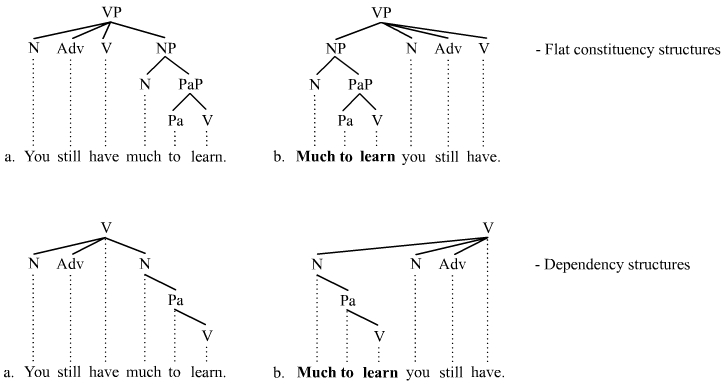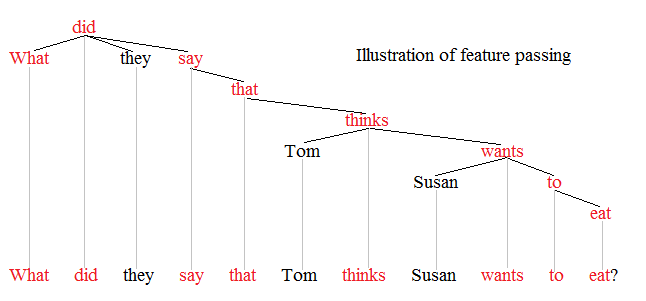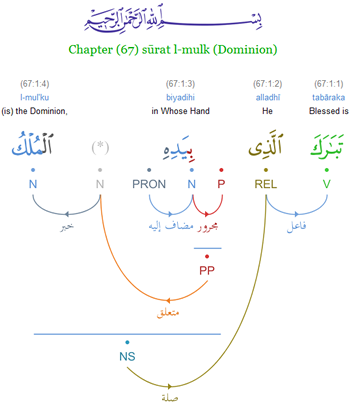|
Topicalization
Topicalization is a mechanism of syntax that establishes an expression as the sentence or clause topic (linguistics), topic by having it appear at the front of the sentence or clause (as opposed to in a canonical position later in the sentence). This involves a phrasal movement of determiners, prepositions, and verbs to sentence-initial position. Topicalization often results in a discontinuity (linguistics), discontinuity and is thus one of a number of established discontinuity types, the other three being wh-movement, ''wh''-fronting, Scrambling (linguistics), scrambling, and extraposition. Topicalization is also used as a Constituent (linguistics), constituency test; an expression that can be topicalized is deemed a constituent. The topicalization of Argument (linguistics), arguments in English is rare, whereas circumstantial Adjunct (grammar), adjuncts are often topicalized. Most languages allow topicalization, and in some languages, topicalization occurs much more frequently an ... [...More Info...] [...Related Items...] OR: [Wikipedia] [Google] [Baidu] |
Discontinuity (linguistics)
In linguistics, a discontinuity occurs when a given word or phrase is separated from another word or phrase that it modifies in such a manner that a direct connection cannot be established between the two without incurring crossing lines in the Parse tree, tree structure. The terminology that is employed to denote discontinuities varies depending on the theory of syntax at hand. The terms ''discontinuous constituent'', ''displacement'', ''long distance dependency'', ''unbounded dependency'', and ''projectivity violation'' are largely synonymous with the term ''discontinuity''. There are various types of discontinuities, the most prominent and widely studied of these being topicalization, wh-fronting, scrambling (linguistics), scrambling, and extraposition. Natural languages vary with respect to the types of discontinuities that they permit. The fixed word order of English allows for relatively few discontinuities compared to, for instance, the Slavic languages, which are much more p ... [...More Info...] [...Related Items...] OR: [Wikipedia] [Google] [Baidu] |
Constituent (linguistics)
In syntactic analysis, a constituent is a word or a group of words that function as a single unit within a hierarchical structure. The constituent structure of sentences is identified using ''tests for constituents''. These tests apply to a portion of a sentence, and the results provide evidence about the constituent structure of the sentence. Many constituents are phrases. A phrase is a sequence of one or more words (in some theories two or more) built around a head lexical item and working as a unit within a sentence. A word sequence is shown to be a phrase/constituent if it exhibits one or more of the behaviors discussed below. The analysis of constituent structure is associated mainly with phrase structure grammars, although dependency grammars also allow sentence structure to be broken down into constituent parts. Tests for constituents in English Tests for constituents are diagnostics used to identify sentence structure. There are numerous tests for constituents that are ... [...More Info...] [...Related Items...] OR: [Wikipedia] [Google] [Baidu] |
Scrambling (linguistics)
Scrambling is a syntax, syntactic phenomenon wherein sentences can be formulated using a variety of different word orders without a substantial change in meaning. Instead the reordering of words, from their canonical position, has consequences on their contribution to the discourse (i.e., the information's "newness" to the conversation). Scrambling does not occur in English language, English, but it is frequent in languages with freer word order, such as German language, German, Russian language, Russian, Persian language, Persian and Turkic languages. The term was coined by John R. Ross, John R. "Haj" Ross in his 1967 dissertation and is widely used in present work, particularly with the generative linguistics, generative tradition. Analysis Discourse Although scrambling does not change the semantic interpretation ("meaning") of the sentence, its scrambled configurations will be given in particular contexts related to discourse. This is the underlying information that cont ... [...More Info...] [...Related Items...] OR: [Wikipedia] [Google] [Baidu] |
Syntactic Movement
Syntactic movement is the means by which some theories of syntax address discontinuities. Movement was first postulated by structuralist linguists who expressed it in terms of ''discontinuous constituents'' or ''displacement''. Some constituents appear to have been displaced from the position in which they receive important features of interpretation. The concept of movement is controversial and is associated with so-called ''transformational'' or ''derivational'' theories of syntax (such as transformational grammar, government and binding theory, minimalist program). Representational theories (such as head-driven phrase structure grammar, lexical functional grammar, construction grammar, and most dependency grammars), in contrast, reject the notion of movement and often instead address discontinuities with other mechanisms including graph reentrancies, feature passing, and type shifters. Illustration Movement is the traditional means of explaining discontinuities such as ... [...More Info...] [...Related Items...] OR: [Wikipedia] [Google] [Baidu] |
Wh-movement
In linguistics, wh-movement (also known as wh-fronting, wh-extraction, or wh-raising) is the formation of syntactic dependencies involving interrogative words. An example in English is the dependency formed between ''what'' and the object position of ''doing'' in "What are you doing?". Interrogative forms are sometimes known within English linguistics as '' wh-words'', such as ''what, when, where, who'', and ''why'', but also include other interrogative words, such as ''how''. This dependency has been used as a diagnostic tool in syntactic studies as it can be observed to interact with other grammatical constraints. In languages with wh- movement, sentences or clauses with a wh-word show a non-canonical word order that places the wh-word (or phrase containing the wh-word) at or near the front of the sentence or clause ("''Whom'' are you thinking about?") instead of the canonical position later in the sentence ("I am thinking about ''you''"). Leaving the wh-word in its canonical pos ... [...More Info...] [...Related Items...] OR: [Wikipedia] [Google] [Baidu] |
Extraposition
Extraposition is a mechanism of syntax that alters word order in such a manner that a relatively "heavy" constituent appears to the right of its canonical position. Extraposing a constituent results in a discontinuity and in this regard, it is unlike shifting, which does not generate a discontinuity. The extraposed constituent is separated from its governor by one or more words that dominate its governor. Two types of extraposition are acknowledged in theoretical syntax: standard cases where extraposition is optional and ''it''-extraposition where extraposition is obligatory. Extraposition is motivated in part by a desire to reduce center embedding by increasing right- branching and thus easing processing, center-embedded structures being more difficult to process. Extraposition occurs frequently in English and related languages. Examples Standard cases of extraposition are optional, although at times the extraposed version of the sentence is strongly preferred. The following ... [...More Info...] [...Related Items...] OR: [Wikipedia] [Google] [Baidu] |
Topic (linguistics)
In linguistics, the topic, or theme, of a sentence is what is being talked about, and the comment (rheme or focus) is what is being said about the topic. This division into old vs. new content is called information structure. It is generally agreed that clauses are divided into topic vs. comment, but in certain cases the boundary between them depends on which specific grammatical theory is being used to analyze the sentence. The topic of a sentence is distinct from the grammatical subject. The topic is defined by pragmatic considerations, that is, the context that provides meaning. The grammatical subject is defined by syntax. In any given sentence the topic and grammatical subject may be the same, but they need not be. For example, in the sentence "As for the little girl, the dog bit her", the subject is "the dog" but the topic is "the little girl". Topic being what is being talked about and the subject being what is doing the action can, also, be distinct concepts fr ... [...More Info...] [...Related Items...] OR: [Wikipedia] [Google] [Baidu] |
Dependency Grammar
Dependency grammar (DG) is a class of modern Grammar, grammatical theories that are all based on the dependency relation (as opposed to the ''constituency relation'' of Phrase structure grammar, phrase structure) and that can be traced back primarily to the work of Lucien Tesnière. Dependency is the notion that linguistic units, e.g. words, are connected to each other by directed links. The (finite) verb is taken to be the structural center of clause structure. All other syntactic units (words) are either directly or indirectly connected to the verb in terms of the directed links, which are called ''dependencies''. Dependency grammar differs from phrase structure grammar in that while it can identify phrases it tends to overlook phrasal nodes. A dependency structure is determined by the relation between a word (a Head (linguistics), head) and its dependents. Dependency structures are flatter than phrase structures in part because they lack a finite verb, finite verb phrase constit ... [...More Info...] [...Related Items...] OR: [Wikipedia] [Google] [Baidu] |
Catena (linguistics)
In linguistics, a catena (English pronunciation: , plural catenas or catenae; from Latin for "chain") is a unit of syntax and morphology (linguistics), morphology, closely associated with dependency grammars. It is a more flexible and inclusive unit than the constituent (linguistics), constituent and its proponents therefore consider it to be better suited than the constituent to serve as the fundamental unit of syntactic and morphosyntactic analysis. The catena has served as the basis for the analysis of a number of phenomena of syntax, such as idiom, idiosyncratic meaning, Ellipsis (linguistics), ellipsis mechanisms (e.g. gapping, stripping (linguistics), stripping, Verb phrase ellipsis, VP-ellipsis, pseudogapping, sluicing, answer ellipsis, comparative deletion), predicate (grammar), predicate-verb argument, argument structures, and Discontinuity (linguistics), discontinuities (topicalization, wh-fronting, Scrambling (linguistics), scrambling, extraposition, etc.). The catena co ... [...More Info...] [...Related Items...] OR: [Wikipedia] [Google] [Baidu] |







